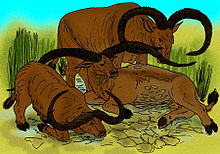Syncerus antiquus
| Syncerus antiquus Temporal range: Late Pleistocene - Holocene
| |
|---|---|

| |
| Skull of Syncerus antiquus | |
| Scientific classification | |
| Domain: | Eukaryota |
| Kingdom: | Animalia |
| Phylum: | Chordata |
| Class: | Mammalia |
| Order: | Artiodactyla |
| Family: | Bovidae |
| Subfamily: | Bovinae |
| Genus: | Syncerus |
| Species: | †S. antiquus
|
| Binomial name | |
| †Syncerus antiquus (Duvernoy, 1851)
| |
| Synonyms | |
| |
Syncerus antiquus is an extinct species of buffalo from the Late Pleistocene and Holocene of Africa.[1] It was one of the largest species in its family, potentially weighing up to 2,000 kilograms (4,400 lb). Due to this fact, it is sometimes known as the African giant buffalo. The time of its extinction is of debate; Syncerus antiquus either became extinct at the end of the Late Pleistocene about 12,000 years ago or during the Holocene, some 4,000 years ago.[2][3]
Taxonomy
Syncerus antiquus was described by Georges Louis Duvernoy in 1851 from a skull discovered along the
In 1949,
Description

Syncerus antiquus holds the distinction of being the largest bovid described from Africa.
One of the defining features of Syncerus antiquus are its massive horns. The largest horn cores can reach sizes of as much as 3 metres (9.8 ft) from tip to tip. The horns resembled those of the wild water buffalo (Bubalus arnee) in shape.[4]
Distribution
This buffalo had the broadest geographic distribution of any recently extinct species of African bovid, being widespread throughout eastern, southern and northern Africa.[3] Material has been dated to the Late Pleistocene, between 107 and 13 ka.[11]
However, rock art from North Africa seemingly depicting Syncerus antiquus suggests that this species survived into the Holocene.[12] Possible fossils of S. antiquus have also been found in Holocene deposits.
Paleoecology

Due to possessing such vast horns, it seems likely that Syncerus antiquus was limited to wide-open areas with few trees.[8] Isotopic and mesowear evidence indicate that it was a grazer, and its massive body size suggests that it consumed large quantities of low-quality forage.[13]
Judging from the rock art, it seems pairs of the male animals (testes are illustrated) would fight by ramming each other's horns with their heads lowered – this is illustrated numerous times. Rock art also suggests that it may have lived in large herds.[4]
Recent survival and extinction

A large amount of
Its extinction has been variously attributed to human predation, climatic change, or some combination of the two.[8]
References
- ^ a b Duvernoy, Georges Louis (December 1851). "note sur une espèce de buffle fossile [Bubalis (Arni) antiquus], découverte en Algérie, caractérisée et décrite par M. Duvernoy". Comptes rendus hebdomadaires des séances de l'Académie des Sciences (in French). 33: 595–597. Retrieved 31 August 2022.
- ISBN 0-8018-5789-9
- ^ .
- ^ from the original on 18 July 2020. Retrieved 31 August 2022.
- .
- ISBN 9780674431256.
- S2CID 55104027. Retrieved 8 January 2020.
- ^ .
- .
- ISBN 9780691156828. Retrieved 31 August 2022.
- S2CID 59359208.
- ^ Gautier, A.; Muzzolini, A. (1991). "The life and times of the giant buffalo alias Bubalus/Homoioceras/Pelorovis antiquus in North Africa". Archaeozoologia. 4: 39–92.
- .
